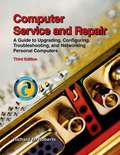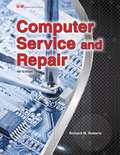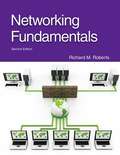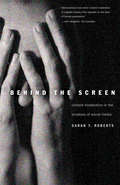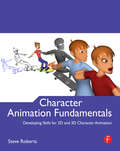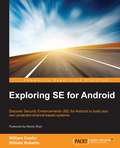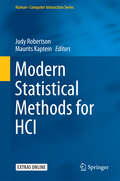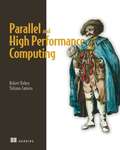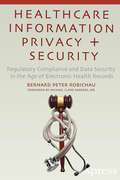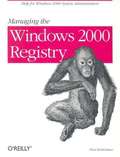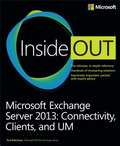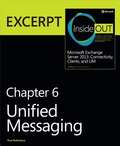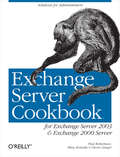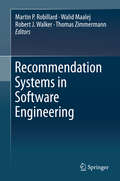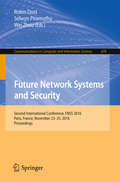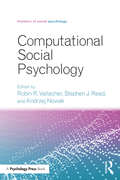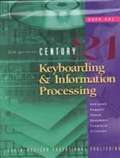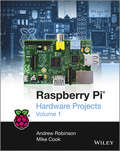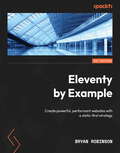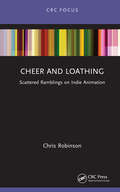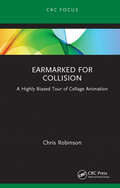- Table View
- List View
Computer Service and Repair: A Guide to Upgrading, Configuring, Troubleshooting, and Networking Personal Computers
by Richard M. RobertsTeaches the practices and principles needed to pass the A+ Certification Exams, as well as to build, upgrade, and troubleshoot your PC.
Computer Service And Repair, 4th Edition
by Richard M. RobertsComputer Service and Repair is written for those who have no PC experience, as well as those technicians who have limited formal training. Written in an easy-to-understand format with hundreds of illustrations, Computer Service and Repair takes the reader from basic instruction to test preparation for the CompTIA A+ Certification exams. For those who want to learn computer networking, programming, administration, or any of the computer sciences, Computer Service and Repair is the perfect place to start.
Behind the Screen: Content Moderation in the Shadows of Social Media
by Sarah T. RobertsAn eye-opening look at the invisible workers who protect us from seeing humanity’s worst on today’s commercial internet Social media on the internet can be a nightmarish place. A primary shield against hateful language, violent videos, and online cruelty uploaded by users is not an algorithm. It is people. Mostly invisible by design, more than 100,000 commercial content moderators evaluate posts on mainstream social media platforms: enforcing internal policies, training artificial intelligence systems, and actively screening and removing offensive material—sometimes thousands of items per day. Sarah T. Roberts, an award-winning social media scholar, offers the first extensive ethnographic study of the commercial content moderation industry. Based on interviews with workers from Silicon Valley to the Philippines, at boutique firms and at major social media companies, she contextualizes this hidden industry and examines the emotional toll it takes on its workers. This revealing investigation of the people “behind the screen” offers insights into not only the reality of our commercial internet but the future of globalized labor in the digital age.
Lens on Life: Documenting Your World Through Photography
by Stephanie C. RobertsMostly candid and spontaneous, documentary photography serves to preserve a moment in time. In Lens on Life, celebrated documentary photographer Stephanie Calabrese Roberts inspires you to explore, shoot, and share documentary photographs, guiding you as you define your own style. Illustrated with the author's striking artwork as well as that of eight seasoned photographers who have visually documented stories all over the world, this book will sharpen your artistic intuition and give you the confidence to take on personal or professional documentary assignments. Full of advice that will challenge you and strengthen your photography, Lens on Life shows you how to capture an authentic view of your world.
Character Animation Fundamentals: Developing Skills for 2D and 3D Character Animation
by Steve RobertsExpand your animation toolkit and remain competitive in the industry with this leading resource for 2D and 3D character animation techniques. Apply the industry's best practices to your own workflows and develop 2D, 3D and hybrid characters with ease. With side by side comparisons of 2D and 3D character design, improve your character animation and master traditional principles and processes including weight and balance, timing and walks. Develop characters inspired by humans, birds, fish, snakes and four legged animals. Breathe life into your character and develop a characters personality with chapters on acting, voice-synching and facial expressions. Expertly integrate core animation techniques with your software of choice featuring step-by-step tutorials, highlighting 3ds Max, Maya and Blender workflows. Adapt the tips, tricks and techniques for unique projects like character design for rotoscoping and motion capture. Advance beyond the fundamentals of 2D and 3D character animation with the companion website which includes short demonstration movies, 2D and 3D exercises and fully rigged character models.
Exploring SE for Android
by William Roberts William ConferThis book is intended for developers and engineers with some familiarity of operating system concepts as implemented by Linux. A basic background in C code would be helpful. Their positions range from hobbyists wanting to secure their Android powered creations to OEM engineers building handsets to engineers of emerging areas where Android is seeing growth.
Adapting Agricultural Extension to Peacebuilding: Roundtable on Technology, Science, and Peacebuilding
by Andrew RobertsonSocieties have sought to improve the outputs of their agricultural producers for thousands of years. In the 19th and early 20th centuries, efforts to convey agricultural knowledge to farmers became known as extension services, a term adopted from programs at Oxford and Cambridge designed to extend the knowledge generated at universities to surrounding communities. Traditionally, extension services have emphasized a top-down model of technology transfer that encourages and teaches producers to use crop and livestock varieties and agricultural practices that will increase food production. More recently, extension services have moved toward a facilitation model, in which extension agents work with producers to identify their needs and the best sources of expertise to help meet those needs. On May 1, 2012, the Roundtable on Science, Technology, and Peacebuilding held a workshop in Washington, DC, to explore whether and how extension activities could serve peacebuilding purposes. The Roundtable is a partnership between the National Academy of Engineering (NAE) and the U. S. Institute of Peace (USIP). It consists of senior executives and experts from leading governmental organizations, universities, corporations, and nongovernmental organizations, was established in 2011 to make a measurable and positive impact on conflict management, peacebuilding, and security capabilities. Its principal goals are: To accelerate the application of science and technology to the process of peacebuilding and stabilization; To promote systematic, high-level communication between peacebuilding and technical organizations on the problems faced and the technical capabilities required for successful peacebuilding; and To collaborate in applying new science and technology to the most pressing challenges for local and international peacebuilders working in conflict zones.
Modern Statistical Methods for HCI
by Judy Robertson Maurits KapteinThisbook critically reflects on current statistical methods used in Human-ComputerInteraction (HCI) and introduces a number of novel methods to the reader. Coveringmany techniques and approaches for exploratory data analysis including effectand power calculations, experimental design, event history analysis,non-parametric testing and Bayesian inference; the research contained in thisbook discusses how to communicate statistical results fairly, as well aspresenting a general set of recommendations for authors and reviewers toimprove the quality of statistical analysis in HCI. Each chapter presents [R]code for running analyses on HCI examples and explains how the results can beinterpreted. ModernStatistical Methods for HCI is aimed at researchers and graduate students who have someknowledge of "traditional" null hypothesis significance testing, but who wishto improve their practice by using techniques which have recently emerged fromstatistics and related fields. This book critically evaluates current practiceswithin the field and supports a less rigid, procedural view of statistics infavour of fair statistical communication.
Parallel and High Performance Computing
by Robert Robey Yuliana ZamoraParallel and High Performance Computing offers techniques guaranteed to boost your code&’s effectiveness. Summary Complex calculations, like training deep learning models or running large-scale simulations, can take an extremely long time. Efficient parallel programming can save hours—or even days—of computing time. Parallel and High Performance Computing shows you how to deliver faster run-times, greater scalability, and increased energy efficiency to your programs by mastering parallel techniques for multicore processor and GPU hardware. About the technology Write fast, powerful, energy efficient programs that scale to tackle huge volumes of data. Using parallel programming, your code spreads data processing tasks across multiple CPUs for radically better performance. With a little help, you can create software that maximizes both speed and efficiency. About the book Parallel and High Performance Computing offers techniques guaranteed to boost your code&’s effectiveness. You&’ll learn to evaluate hardware architectures and work with industry standard tools such as OpenMP and MPI. You&’ll master the data structures and algorithms best suited for high performance computing and learn techniques that save energy on handheld devices. You&’ll even run a massive tsunami simulation across a bank of GPUs. What's inside Planning a new parallel project Understanding differences in CPU and GPU architecture Addressing underperforming kernels and loops Managing applications with batch scheduling About the reader For experienced programmers proficient with a high-performance computing language like C, C++, or Fortran. About the author Robert Robey works at Los Alamos National Laboratory and has been active in the field of parallel computing for over 30 years. Yuliana Zamora is currently a PhD student and Siebel Scholar at the University of Chicago, and has lectured on programming modern hardware at numerous national conferences. Table of Contents PART 1 INTRODUCTION TO PARALLEL COMPUTING 1 Why parallel computing? 2 Planning for parallelization 3 Performance limits and profiling 4 Data design and performance models 5 Parallel algorithms and patterns PART 2 CPU: THE PARALLEL WORKHORSE 6 Vectorization: FLOPs for free 7 OpenMP that performs 8 MPI: The parallel backbone PART 3 GPUS: BUILT TO ACCELERATE 9 GPU architectures and concepts 10 GPU programming model 11 Directive-based GPU programming 12 GPU languages: Getting down to basics 13 GPU profiling and tools PART 4 HIGH PERFORMANCE COMPUTING ECOSYSTEMS 14 Affinity: Truce with the kernel 15 Batch schedulers: Bringing order to chaos 16 File operations for a parallel world 17 Tools and resources for better code
Healthcare Information Privacy and Security
by Bernard Peter RobichauHealthcare IT is the growth industry right now, and the need for guidance in regard to privacy and security is huge. Why? With new federal incentives and penalties tied to the HITECH Act, HIPAA, and the implementation of Electronic Health Record (EHR) systems, medical practices and healthcare systems are implementing new software at breakneck speed. Yet privacy and security considerations are often an afterthought, putting healthcare organizations at risk of fines and damage to their reputations. Healthcare Information Privacy and Security: Regulatory Compliance and Data Security in the Age of Electronic Health Records outlines the new regulatory regime, and it also provides IT professionals with the processes and protocols, standards, and governance tools they need to maintain a secure and legal environment for data and records. It's a concrete resource that will help you understand the issues affecting the law and regulatory compliance, privacy, and security in the enterprise. As healthcare IT security expert Bernard Peter Robichau II shows, the success of a privacy and security initiative lies not just in proper planning but also in identifying who will own the implementation and maintain technologies and processes. From executive sponsors to system analysts and administrators, a properly designed security program requires that that the right people are assigned to the right tasks and have the tools they need. Robichau explains how to design and implement that program with an eye toward long-term success. Putting processes and systems in place is, of course, only the start. Robichau also shows how to manage your security program and maintain operational support including ongoing maintenance and policy updates. (Because regulations never sleep ) This book will help you devise solutions that include: Identity and access management systems Proper application design Physical and environmental safeguards Systemwide and client-based security configurations Safeguards for patient data Training and auditing procedures Governance and policy administration Healthcare Information Privacy and Security is the definitive guide to help you through the process of maintaining privacy and security in the healthcare industry. It will help you keep health information safe, and it will help keep your organizationwhether local clinic or major hospital systemon the right side of the law. What you'll learn The basics ofHITECH, HIPAA, and other federal laws driving change in healthcare IT How to identify the core issues of privacy and security in a healthcare environment. The steps required to develop and execute a security project plan. The technologies and tools available to aid in the process of deploying a secure EHR system. The core regulatory issues and practical matters of security in a healthcare environment. The frameworks and methodology that will assist in tackling the issues of privacy and security. The technologies impacted by matters of privacy and security along with proposals for managing them effectively. Who this book is for Healthcare professionals who work in information technology, information security, health information management, as well as in the more specialized areas of privacy, compliance, and informatics. The book is also useful for consultants working in the field of information security who require a better understanding of the challenges facing the healthcare industry, EMR Vendors who are tasked with guiding their customers through a secure implementation of their product, and technology professionals seeking to make an entry into the world of Healthcare IT. Table of ContentsChapter 1. Introduction: The Long-Awaited Manual Chapter 2. Waking the Sleeping Giant: A Brief History of Healthcare ITChapter 3. It's Not Just HIPAA: Legislating Privacy and SecurityChapter 4. Assembling the Team: Bringing the Right Human Resources to the TableChapter 5. Sifting Through the Wreckage: The Security Audit C
Managing the Windows 2000 Registry
by Paul RobichauxThe Windows 2000 Registry is the repository for all hardware, software, and application configuration settings. Managing the Windows 2000 Registry is the system administrator's guide to maintaining, monitoring, and updating the Registry database. A "must-have" for every 2000 system manager or administrator, it covers what the Registry is and where it lives on disk, available tools, Registry access from programs, and Registry content.
Microsoft Exchange Server 2013 Inside Out: Connectivity, Clients, and UM
by Paul RobichauxWith a focus on connectivity, clients, and unified messaging, this book delivers the ultimate, in-depth reference to IT professionals planning and managing an Exchange Server 2013 deployment. Guided by Paul Robichaux, a Microsoft MVP and popular author, you will: Understand how Exchange Server 2013 works with previous versions Gain expert insights into supporting clients, mobile devices, and UM Take a deep dive into front-end servers; certificate and namespace management; transport rules; load balancing; client management, including Microsoft Outlook, Outlook Web App (OWA), and POP3/IMAP4; mobile devices; anti-malware and anti-spam features; Unified Messaging; Microsoft Lync; Office 365; Exchange Online.
Unified Messaging: EXCERPT from Microsoft Exchange Server 2013 Inside Out
by Paul RobichauxThis content is a direct excerpt of Chapter 7 from the book Microsoft Exchange Server 2013 Inside Out: Connectivity, Clients, & UM. This concise ebook is offered independently of the larger book for Exchange administrators seeking specific, focused information on managing Unified Messaging. Directly excerpts Chapter 7 from the book Microsoft Exchange Server 2013 Inside Out: Connectivity, Clients, & UM Offered as concise, standalone content for Exchange professionals looking for narrowly focused reference or specific problem-solving information on managing Unified Messaging and voice-related features Written by popular author Paul Robichaux, MVP for Exchange Server
Exchange Server Cookbook
by Paul Robichaux Devin L. Ganger Missy KosloskyAsk network administrators what their most critical computer application is, and most will say "email" without a moment's hesitation. If you run a network powered by Windows 2000 or Windows Server 2003, Microsoft Exchange occupies much of your time. According to Microsoft, 110 million Exchange seats have been deployed, but 60% of you are still running Exchange 5.5. That's a problem, because the difference between version 5.5 and the more efficient Exchange 2000 and Exchange Server 2003 is profound. Don't fret. Exchange Server Cookbook offers you a comprehensive how-to guide to these newer versions of Exchange. You'll find quick solutions for the most common tasks you need to perform--everything from installation and maintenance to configuration and optimization, with proven recipes for the most useful tools and utilities. The book also has solutions to some uncommon tasks (that you may not know are possible) and advanced procedures that aren't part of day-to-day operations. These include tasks for critical situations, such as using a recovery storage group. Our reliable desktop reference even shows you how to write scripts for Exchange management and deployment tasks. That's right. While not every Exchange job can be scripted, many can, and we provide lots of working VBScript examples for accomplishing particular goals. Whatever your particular need, you'll find it quickly, because chapters in this Cookbook are laid out by recipe, with cross references to other pertinent solutions in the book. With this guide, you'll learn: The relationship between Exchange and Active Directory When to use the GUI, the command line, or scripting How to prepare forests, domains, and servers How to use Group Policy to control Exchange Diagnostic logging, measure performance, and administrative privileges Recipient management: user accounts, mailboxes, mail-enabled groups Mailbox and public folder database management Message routing and transport functions Security, backup, restore, and recovery operations For every question you have about Exchange 2000 or Exchange Server 2003, our Cookbook has the answer--one that you can find and implement without a moment's hesitation.
Das einfache und emotionale Kauferlebnis: Mit Usability, User Experience und Customer Experience anspruchsvolle Kunden gewinnen
by Johannes RobierBei der Entscheidung eines Kunden für den Kauf eines Produktes oder Dienstleistung sind viele Faktoren wichtig, die bewusst oder unbewusst wahrgenommen werden. Ausschlaggebend für Kaufentscheidung ist letztlich jedoch ein Gefühl des Vertrauens, das der Kunde entwickelt hat. Dieser "Reason to believe" ist der entscheidende Faktor, warum Produkte gekauft, weshalb Dienstleistungen in Anspruch genommen und wieso Kunden zu loyalen Stammkunden werden. Dieses Buch zeigt Ihnen von den psychologischen Grundlagen der Informationsvermittlung bis hin zu methodischen Anwendungen, wie Sie den ,,Reason to Believe" Ihrer Produkte und Dienstleitungen strukturiert erarbeiten, kommunizieren und in den Vordergrund stellen können.
Recommendation Systems in Software Engineering
by Martin P. Robillard Walid Maalej Robert J. Walker Thomas ZimmermannWith the growth of public and private data stores and the emergence of off-the-shelf data-mining technology, recommendation systems have emerged that specifically address the unique challenges of navigating and interpreting software engineering data. This book collects, structures and formalizes knowledge on recommendation systems in software engineering. It adopts a pragmatic approach with an explicit focus on system design, implementation, and evaluation. The book is divided into three parts: "Part I - Techniques" introduces basics for building recommenders in software engineering, including techniques for collecting and processing software engineering data, but also for presenting recommendations to users as part of their workflow. "Part II - Evaluation" summarizes methods and experimental designs for evaluating recommendations in software engineering. "Part III - Applications" describes needs, issues and solution concepts involved in entire recommendation systems for specific software engineering tasks, focusing on the engineering insights required to make effective recommendations. The book is complemented by the webpage rsse. org/book, which includes free supplemental materials for readers of this book and anyone interested in recommendation systems in software engineering, including lecture slides, data sets, source code, and an overview of people, groups, papers and tools with regard to recommendation systems in software engineering. The book is particularly well-suited for graduate students and researchers building new recommendation systems for software engineering applications or in other high-tech fields. It may also serve as the basis for graduate courses on recommendation systems, applied data mining or software engineering. Software engineering practitioners developing recommendation systems or similar applications with predictive functionality will also benefit from the broad spectrum of topics covered.
Future Network Systems and Security: Second International Conference, FNSS 2016, Paris, France, November 23-25, 2016, Proceedings (Communications in Computer and Information Science #670)
by Robin Doss, Selwyn Piramuthu and Wei ZhouThis book constitutes the refereed proceedings of the Second International Conference on Future Network Systems and Security, FNSS 2016, held in Paris, France, in November 2016.The 12 full papers and one short paper presented were carefully reviewed and selected from 34 submissions. The papers focus on the technology, communications, systems and security aspects of relevance to the network of the future.
Computational Social Psychology (Frontiers of Social Psychology)
by Robin R. Vallacher; Stephen J. Read; Andrzej NowakComputational Social Psychology showcases a new approach to social psychology that enables theorists and researchers to specify social psychological processes in terms of formal rules that can be implemented and tested using the power of high speed computing technology and sophisticated software. This approach allows for previously infeasible investigations of the multi-dimensional nature of human experience as it unfolds in accordance with different temporal patterns on different timescales. In effect, the computational approach represents a rediscovery of the themes and ambitions that launched the field over a century ago. The book brings together social psychologists with varying topical interests who are taking the lead in this redirection of the field. Many present formal models that are implemented in computer simulations to test basic assumptions and investigate the emergence of higher-order properties; others develop models to fit the real-time evolution of people’s inner states, overt behavior, and social interactions. Collectively, the contributions illustrate how the methods and tools of the computational approach can investigate, and transform, the diverse landscape of social psychology.
Classic Shell Scripting
by Arnold Robins Nelson BeebeShell scripting skills never go out of style. It's the shell that unlocks the real potential of Unix. Shell scripting is essential for Unix users and system administrators-a way to quickly harness and customize the full power of any Unix system. With shell scripts, you can combine the fundamental Unix text and file processing commands to crunch data and automate repetitive tasks. But beneath this simple promise lies a treacherous ocean of variations in Unix commands and standards. Classic Shell Scripting is written to help you reliably navigate these tricky waters. Writing shell scripts requires more than just a knowledge of the shell language, it also requires familiarity with the individual Unix programs: why each one is there, how to use them by themselves, and in combination with the other programs. The authors are intimately familiar with the tips and tricks that can be used to create excellent scripts, as well as the traps that can make your best effort a bad shell script. With Classic Shell Scripting you'll avoid hours of wasted effort. You'll learn not only write useful shell scripts, but how to do it properly and portably. The ability to program and customize the shell quickly, reliably, and portably to get the best out of any individual system is an important skill for anyone operating and maintaining Unix or Linux systems. Classic Shell Scripting gives you everything you need to master these essential skills.
Keyboarding and Information Processing (Book One) (Sixth Edition)
by Amanda Robinson Lee R. Beaumont T. James Crawford Jack P. Hoggatt Jerry W. Robinson Jon A. ShankIn today's world of people doing business anytime, anywhere from PC's and laptops, proper keyboarding skills are essential. While solid keyboarding skills never change, the applications and software do. That's why Century 21 Keyboarding not only teaches users the fundamentals, it also keeps them current with new technology-a reputation it's held for more than 75 years.
Raspberry Pi Hardware Projects 1
by Andrew RobinsonLearn how to take full advantage of all of Raspberry Pi's amazing features and functions--and have a blast doing it!Congratulations on becoming a proud owner of a Raspberry Pi, the credit-card-sized computer! If you're ready to dive in and start finding out what this amazing little gizmo is really capable of, this ebook is for you.Taken from the forthcoming Raspberry Pi Projects, Raspberry Pi Hardware Projects 1 contains three cool hardware projects that let you have fun with the Raspberry Pi while developing your Raspberry Pi skills. The authors - PiFace inventor, Andrew Robinson and Raspberry Pi For Dummies co-author, Mike Cook - show you how to build:Reaction timerTwittering toyDisco LightsThe ebook also includes a brief guide to setting up the Raspberry Pi for those very new to its unique ways and a bonus project, the Insult Generator, which will teach you simple Python programming while making you laugh.With Raspberry Pi Hardware Projects 1 you'll learn everything you need to know to program the Raspberry Pi and build cool, automated and interactive gadgets in no time.
Eleventy by Example: Create powerful, performant websites with a static-first strategy
by Bryan RobinsonBuild faster static sites by leveraging CDN and creating custom tools and workflows with 5 real-world projectsPurchase of the print or Kindle book includes a free PDF eBookKey FeaturesLearn how to use and extend 11ty, one of the most flexible static site generators in the industry.Optimize your experience by customizing 11ty to suit various projects' needsCreate request-time experiences without recreating templates with 11ty ServerlessBook Description11ty is the dark horse of the Jamstack world, offering unparalleled flexibility and performance that gives it an edge against other static site generators such as Jekyll and Hugo. With it, developers can leverage the complete Node ecosystem and create blazing-fast, static-first websites that can be deployed from a content delivery network or a simple server. This book will teach you how to set up, customize, and make the most of 11ty in no time. Eleventy by Example helps you uncover everything you need to create your first 11ty website before diving into making more complex sites and extending 11ty's base functionality with custom short codes, plugins, and content types. Over the course of 5 interactive projects, you'll learn how to build basic websites, blogs, media sites, and static sites that will respond to user input without the need for a server. With these, you'll learn basic 11ty skills such as templates, collections, and data use, along with advanced skills such as plugin creation, image manipulation, working with a headless CMS, and the use of the powerful 11ty Serverless plugin. By the end of this book, you'll be well-equipped to leverage the capabilities of 11ty by implementing best practices and reusable techniques that can be applied across multiple projects, reducing the website launch time.What you will learnCreate a basic website with reusable templates and globally available dataBuild a blog using 11ty's collectionsSet up a photography site that uses the 11ty Image plugin to deploy properly sized imagesConnect a content management system to provide an enhanced editor and developer experienceModel an enhanced search experience with no dedicated server through serverless functions and 11ty ServerlessBoost productivity by creating custom 11ty tools and pluginsWho this book is forThis book is for anyone looking to build efficient websites while shipping less JavaScript to the client. Strong knowledge of HTML and CSS and beginner-level knowledge of JavaScript and the Node.js ecosystem, including querying APIs is a must.
Cheer and Loathing: Scattered Ramblings on Indie Animation (Focus Animation Ser.)
by Chris RobinsonOne of the most acclaimed writers in animation returns with this informal sequel to his previous books on indie animation, Unsung Heroes of Animation, Animators Unearthed, and Mad Eyed Misfits. In this collection, award-winning writer, Chris Robinson, looks at a wide range of films, topics (sex, censorship, cultural politics, programming, felt, gifs, VR, dogs) and filmmakers (Masaaki Yuasa, Xi Chen, Gil Alkabetz, Jacques Drouin, Bordo, Rosto, Joaquín Cociña, Cristóbal León, George Schwizgebel, Lizzy Hobbs, Andreas Hykade, Leah Shore, and many others). Eclectic, brief, fiery, and opinionated, Robinson’s gonzo-tinged writing will amuse, confuse, annoy, and maybe even inspire while, hopefully introducing readers to the wonders of independently-produced animation.
Earmarked for Collision: A Highly Biased Tour of Collage Animation
by Chris RobinsonCollage art and film date back to the early 20th century (the earliest collages have roots in 12th-century Japan). It was rooted in the age of consumerism where artists addressed an array of political and social issues by creating a carefully crafted collision of pre-existing images and sounds to generate new meanings and commentaries on the surrounding world. Collage has also pushed the boundaries of animation, by incorporating other artistic forms (e.g., photography, live action, experimental cinema, literature, found sound) while exploring an array of social, cultural, and political issues. In Earmarked for Collision, award-winning writer Chris Robinson (The Animation Pimp, Mad Eyed Misfits, Unsung Heroes of Animation) takes us on a tour of the history of collage animation, cataloguing the collage works of notable artists like Larry Jordan, Harry Smith, Stan Vanderbeek, Terry Gilliam, Janie Geiser, Martha Colburn, Lewis Klahr, Run Wrake, Lei Lei, Kelly Sears, Jodie Mack, and many, many others.
